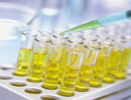LifeScienceHistory.com - Check us out on Instagram
Take Your Next Career Step with Lundback
Synthesis and Purification

The research process is complicated, time-consuming, and costly and the end result is never guaranteed. Literally
hundreds and sometimes thousands of chemical compounds must be made and tested in an effort to find one that can
achieve a desirable result.
FDA estimates that it takes approximately eight-and-a-half years to study and test a new drug before it can be
approved for the general public. This estimate includes early laboratory and animal testing, as well as later clinical
trials using human subjects.
There is no standard route through which drugs are developed. A pharmaceutical company may decide to develop a new
drug aimed at a specific disease or medical condition. Sometimes, scientists choose to pursue an interesting or promising
line of research. In other cases, new findings from university, government, or other laboratories may point the way for
drug companies to follow with their own research.
New drug research starts with an understanding of how the body functions, both normally and abnormally, at its most
basic levels. The questions raised by this research help determine a concept of how a drug might be used to prevent,
cure, or treat a disease or medical condition. This provides the researcher with a target. Sometimes, scientists find
the right compound quickly, but usually hundreds or thousands must be screened. In a series of test tube experiments
called assays, compounds are added one at a time to enzymes, cell cultures, or cellular substances grown in a
laboratory. The goal is to find which additions show some effect. This process may require testing hundreds of
compounds since some may not work, but will indicate ways of changing the compound's chemical structure to improve
its performance.
Computers can be used to simulate a chemical compound and design chemical structures that might work against it.
Enzymes attach to the correct site on a cell's membrane, which causes the disease. A computer can show scientists what
the receptor site looks like and how one might tailor a compound to block an enzyme from attaching there. But even
though computers give chemists clues as to which compounds to make, a substance must still be tested within a living
being.
Another approach involves testing compounds made naturally by microscopic organisms. Candidates include fungi,
viruses and molds, such as those that led to penicillin and other antibiotics. Scientists grow the microorganisms in
what is known as a "fermentation broth," with one type of organism per broth. Sometimes, 100,000 or more broths are tested
to see whether any compound made by a microorganism has a desirable effect.
Source: U.S. Food and Drug Administration Center for Drug Evaluation and Research Handbook.
Back to The New Drug Development Process